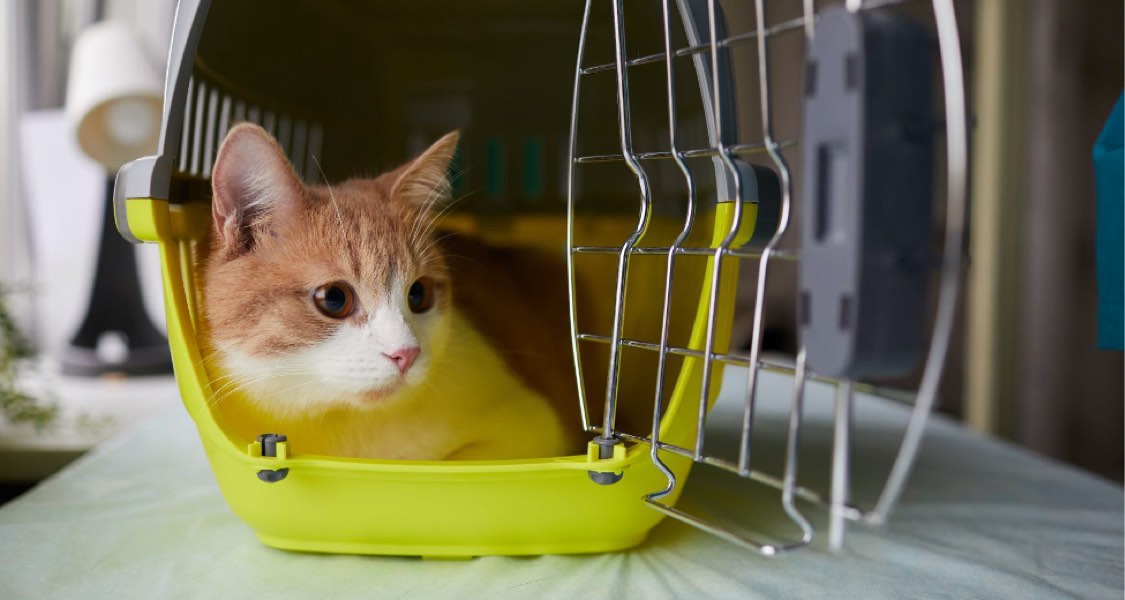Maybe you’ve always known you wanted to travel with your cat. Or, maybe you’re just hoping to get him back and forth to the vet without all the drama… believe me, we get it! If given the choice, most cats would prefer to stay in their familiar space and comfort zone.
But that doesn’t mean that cats can’t learn to enjoy, or at least tolerate, a ride in the car. Of course, you’ll have to take steps to prepare them for the journey and make traveling by car as safe, easy, and stress-free as possible.
Here are our top tips for traveling with a cat in a car, whether you’re visiting the vet across town or moving across the country.
1. Start by Getting Your Cat Used to a Harness and Leash
When traveling with your cat in the car, he should have a harness on at all times. That way you can easily attach a leash any time you have to take him out of the carrier, such as when he needs to use the litter box, stretch his legs, or get a drink of water. It’s much easier to quickly grab a trailing leash than it is to try to catch a squirming, freaked out cat.
You don’t have to go all out and leash train your cat if you don’t think that’s something he would enjoy. But you should spend some time getting him used to the harness before your trip. Start by letting him sniff it, then put it on him for a few minutes each day. Increase the time gradually until he’s totally comfortable wearing the harness for long periods.
Once he’s used to the harness, attach the leash for a few minutes every day. Make sure the harness is properly adjusted so that your cat can’t squirm out of it when the leash is attached. Collars are not an acceptable replacement for a properly fitted harness because cats can easily slip them over their head.
2. An Up to Date ID Tag and Microchip Are Essential
A microchip is essential for helping your cat find his way home if he gets lost. And, it will be the only way to identify your cat if he somehow loses his ID tag. But it can only be read by a special microchip reader at a vet’s office or shelter
Attaching an ID tag to your cat’s harness will ensure that anyone who picks him up can get in touch with you right away. Say your cat slips out the door to your room at the hotel… his ID tag will ensure that whoever finds him has a way to contact you, so he doesn’t end up at the shelter.
Of course, neither one of these options will be very helpful if you don’t keep your contact information up to date! Be sure to update your address and phone number with the microchip registry and on the ID tag if you’ve made any changes.
3. Have a Checkup and Vaccines
If you’re going to be taking your kitty on a road trip, be sure to have a checkup and any necessary vaccinations taken care of before you go. The last thing you want is for your kitty to get ill while you’re on your trip. And getting turned away from a hotel because you don’t have current vaccination records isn’t any fun either.
Doctors at Bond Vet Clinic recommend having “a current copy of your cat’s vaccination records and health history with you anytime you’re traveling out of your local area.” Depending on which state you are traveling to, a health certificate may also be required.
4. Choose the Right Carrier
Choosing the right carrier can make or break your cat’s trip, whether it’s just a visit to the vet or a road trip across the country. A hard-sided plastic carrier is essential for your cat’s safety. That way if you are in an accident, your kitty will be protected. Plastic carriers are also easier to wipe clean, which is a major bonus when you’re on the road.
When it comes to the size of the carrier, that really depends on the length of your trip and the size of your car. Keep in mind that cats prefer cozy spaces, so bigger isn’t necessarily better.
For short trips, a carrier that’s just big enough for the cat to stand up, turn around, and stretch out comfortably is a good choice. For longer trips, you may want to consider getting a larger crate with room for a travel litter box so your kitty can potty whenever he needs to.
5. Make the Carrier More Inviting to Your Cat
Many cats hate and mistrust the carrier on sight, so anything you can do to make it more inviting can be a huge help. Start by adding a cozy bed. You might also toss in a catnip toy and a t-shirt that smells like you. A few of his favorite treats will also be an excellent motivator.
6. Help Your Cat Learn to Love His Carrier
Once you’ve chosen a carrier and made it cozy, it’s time to acquaint your cat with the carrier. Start by making the carrier part of his environment. Put it in a spot in the house where he enjoys spending time. Toss a few treats in there each day and add a little catnip or pheromone spray to sweeten the deal.
Play with your kitty near and inside the carrier. Once he starts entering the carrier on his own, close the door and leave the room for just a minute or two and then come back and open it up. Gradually increase the amount of time you leave the door shut over the course of a few days or even a week.
Once he’s used to that, walk around the house a bit with your kitty inside the carrier. Set it down, pick it up, and even walk outside.
Be sure to offer plenty of treats and positive reinforcement every time you let him out of the carrier. However, don’t make a fuss when you put him inside because you want him to learn that it’s no big deal.
7. Acclimate Him to the Car Slowly
Now that your kitty only associates his carrier with good things, it’s time to acclimate him to the car. Start with short trips around the block for a few days. Gradually increase the distance over time, being sure to offer goodies when you get home.
The idea is to help your cat understand that being in the carrier doesn’t automatically equal something unpleasant, like going to the vet. He may never learn to love the car, but hopefully, he’ll learn to accept it without a lot of drama.
8. Secure the Carrier in the Car with a Seat Belt
When you load your cat and carrier into the car, put it in the backseat and secure it in place with a seatbelt. Don’t put him in the front seat in case the airbag deploys due to a fender bender or serious accident. Securing him with the seat belt ensures that he won’t go flying if you have to slam on the breaks, risking injury to him and you if his carrier becomes a flying projectile.
9. Have a Plan for Car Sickness
Your test runs should give you a good indication of how your kitty’s tummy is going to do on longer trips. If he gets car sick, talk to your vet about anti-nausea medication. It’s also a good idea to avoid feeding him right before a trip or while he’s in the car.
10. Don’t Take Your Cat Out of the Carrier When Traveling
No matter how loudly your cat protests in the car, don’t be tempted to take him out of the carrier and let him roam around the car. If he gets under your feet or distracts you in some way, it could seriously impair your ability to drive safely.
And, if you’re in an accident or have to slam on the breaks, your cat could be seriously hurt without the protection of his carrier. Look at it this way… you buckle in for safety, so why wouldn’t you buckle your kitty in, too?
11. Plan for Potty Breaks
If you’re going to be on the road for a while and your cat’s carrier isn’t big enough to hold a litter box, plan to stop for potty breaks every few hours. You can bring a folding, travel litter box, or a disposable litter box, to put on the floor in the car. Be sure to bring his familiar litter from home so he knows that’s where he’s supposed to go. Don’t forget a litter scoop and poop bags so you clean up afterward.
You should only let your kitty out of his carrier for potty breaks when the car is parked. Be sure to attach his leash to his harness and double-check that all of the car doors are securely closed. Supervise him the entire time to ensure he doesn’t find a place to hide, like up in the dashboard where you can’t get to him.
12. How to Handle Food and Water
Don’t put a water bowl in the carrier with your cat because it will spill and that’s not going to make anyone happy. A water bottle, like the ones used for rabbits, can be a great choice if your cat will use it. Otherwise, you can offer water when you stop for potty breaks.
When it comes to food, you might be better off just feeding your cat when you get to your destination. That way, there’s less chance of stomach upset while you’re on the road.
13. Make Special Considerations for Cats with Health Concerns
If your cat has a health condition, be sure to bring extra medication and food with you. Don’t count on being able to find what you need along the way. Cats with diabetes, kidney issues, and other health problems will need to go to the bathroom more often. You’ll have to make pit stops more frequently or choose a carrier that’s big enough to hold a litter box.
14. Confirm Lodging in Advance
If you will be staying in a hotel or a vacation rental during your trip, always check in advance to ensure that they allow pets. When you make your reservation, get the agent’s name and request a written confirmation that your cat will be welcome when you get there.
Don’t try to sneak your cat into the hotel or rental! While you may get away with it, if you don’t, you’ll be stuck driving around in a strange town looking for a pet-friendly hotel.
Even if you’re staying with friends or family during your trip, you should still make sure they’re ok with you bringing your cat, too. Maybe a household member is allergic to cats. Or, maybe their dog is aggressive with other animals. It’s always better to be safe than sorry.
15. Inspect Accommodations Carefully
Once you arrive at your destination, get down on your cat’s level, and inspect everything to ensure that there’s nothing that could harm your cat. Look for things like exposed electrical cords, things he might pick up and eat, and mini blind cords he could get tangled up in.
Check for holes in walls or under the bed that he might be able to crawl into and hide. Don’t forget to look for dangerous chemicals around the room and under the bathrooms sink… not just cleaning products, but also mouse or insect traps.
Close the lid on the toilet so your cat can’t drink out of it. Not only is it gross, but there could also be chemicals in it.
If you’re renting an apartment or house or staying in a friend’s home, it will be much less stressful for your cat if you keep him in one room, preferably your bedroom so he can be with you at night.
Anytime you don’t feel like the room is completely safe, consider confining your cat to the bathroom. If the bathroom doesn’t seem safe either, your kitty should stay in his carrier when you’re not supervising him closely.
You might also consider bringing a folding cat playpen that offers a safe place for your cat to eat, sleep, play, and go to the bathroom without you having to worry about cat proofing an entire room.
16. Prepare for Stress
No matter what you do, some cats will still be stressed in the car. You can reduce your cat’s stress to some extent by keeping the music low and driving nice and easy to keep the ride as smooth as possible. Feliway pheromone spray or a Thunder Shirt can be super helpful for lowering anxiety naturally.
If your cat is especially prone to anxiety in the car, talk to your vet about getting a prescription for anti-anxiety medication. There are several options to choose from, whether you just want to take the edge off or you need something a bit stronger.
17. A Little Exercise Can Go a Long Way
Before you hit the road, break out your kitty’s favorite toys and try to wear him out a little. Chasing a laser pointer or running after his tinkle ball will burn off some energy and reduce anxiety. A little exercise might tire him out enough that he’ll nap for the entire trip.
18. Plan for Extreme Temperatures
Extreme temperatures are a major concern when you’re traveling with your cat in the car. Sure, you’ll be with your cat and able to regulate the temperature most of the time. It goes without saying that you should never leave your cat alone in the car for more than a few minutes.
But, what about when you have to stop for food, gas, or to go to the bathroom? And, what if the AC, heat, or the car itself breaks down?
If you’re traveling when it’s likely to be hot outside bring a cooling pad, ice packs, or even frozen bottles of water to put in your cat’s carrier and help him stay cool if needed. In the winter, bring an extra blanket to cover his carrier and hold in his body heat, just in case.
19. Be Prepared for Emergencies on the Road
In addition to your cat’s vaccine and health records, you should have a Cat First Aid Kit in the car on your trip. Be sure to know where the closest 24-hour emergency vet is to your destination, just in case something comes up. It’s also a good idea to know how to contact Animal Poison Control if your kitty manages to eat something he shouldn’t.
20. Bring Some Clean-up Essentials
Don’t forget to bring a few basic supplies for cleaning up those inevitable messes along the way. Paper towels and a pet-safe spray cleaner are a must. Baby wipes or pet wipes are great to have for cleaning up your kitty if he gets sick or messy in some way. And, don’t forget to bring some plastic bags for soiled bedding and trash.
21. Wrapping It Up
Every cat has to ride in the car at some point, even if it’s just a trip to the vet. The good news is, most cats can learn to love car travel, or at least tolerate it, with a little practice. With some careful planning and advanced preparation, as well as some special considerations along the way, the experience can be a positive one for you and your cat.











